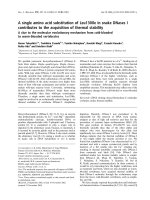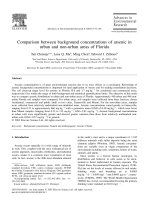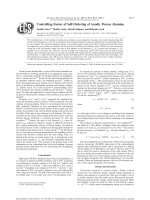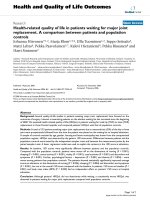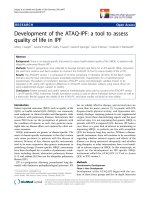- Trang chủ >>
- Khoa Học Tự Nhiên >>
- Vật lý
a comparison between self - ordering of nanopores in aluminium oxide
Bạn đang xem bản rút gọn của tài liệu. Xem và tải ngay bản đầy đủ của tài liệu tại đây (507.61 KB, 4 trang )
A comparison between self-ordering of nanopores in aluminium oxide
films achieved by two- and three-step anodic oxidation
F. Nasirpouri
*
, M. Abdollahzadeh, M.J. Almasi, N. Parvini-Ahmadi
Department of Materials Engineering, Sahand University of Technology, Tabriz 53317-11111, Iran
article info
Article history:
Available online 31 August 2008
PACS:
61.46.Àw
81.07.Àb
68.37.Hk
78.55.Mb
82.45.Cc
Keywords:
Nano-scale materials
Anodic aluminum oxide
Nanopore
Self ordered
Three step
abstract
We report on the enhancement of naturally-occurred self-ordering of nanopores in anodic aluminium
oxide (AAO) membrane by performing three step anodic oxidation. Two and three step anodic oxidation
methods were used to achieve self ordering of nanopores and the ordering of nanopores obtained by the
methods were compared. The current–time curves, recorded during anodization, elucidate an almost
similar features for all three steps in both methods. Scanning electron micrographs (SEM) show hexago-
nally arranged nanopores in a way which forms highly ordered areas or ordered domains. Domains are
placed beside each other like a polycrystalline structure after two and three step anodizing, while larger
ones are clearly observed over the surface after three step anodizing. More uniform nanopores with nar-
rower size distribution are observed for AAO films of three step anodic oxidation.
Ó 2008 Elsevier B.V. All rights reserved.
1. Introduction
The template synthesis is known as an elegant electrochemical
approach for the fabrication of nanomaterials such as nanowires
and can be considered as an alternative choice to the other sophis-
ticated methods such as molecular beam epitaxy and nanolithog-
raphy [1]. The fabrication method may include electrochemically
synthesis of thin fibrils into cylindrical pores of the template [2].
Among the frequently used templates, anodic aluminium oxide
films provide highly ordered pore arrangements due to the self-
organizing process, introduced by Masuda et al. under the applica-
tion of anodic oxidation process for two steps [3–6]. AAO mem-
branes with pore density of 10
10
–10
12
cm
À2
, are formed by
anodizing Al in appropriate acidic electrolytes such as oxalic acid
[4,5]. The typical structure of the film consists of a thin non-porous
barrier oxide layer which lies adjacent to the Al substrate and a
porous layer on the top [7–8]. The top layer contains an array of
hexagonally close-packed cylindrical cells at the center of which
a straight hole is located. The formation of the porous structure re-
sults from the effect of a dynamic mechanical equilibrium between
the film growth at the aluminium-oxide interface and the field-as-
sisted oxide dissolution at the oxide–electrolyte interface [6,7].
Most of the reports on obtaining highly ordered AAO have been
focused on using two step anodizing process in which the duration
of the first step has a considerable effect on the formation of highly
ordered polycrystalline domains. As the duration of the first step
increases, the domains in the bottom of porous oxide layer form
on larger areas [3,7]. Therefore, the effect of the first step of anod-
ization on the ordering of nanopores is remarkable to achieve bet-
ter cell arrangements of nanopores. In this paper, we aim to
demonstrate the effect of three step anodization of aluminium on
the ordering of the nanopores in AAO films.
2. Experiments
High purity Al foil (99.999%) was used as substrate after cutting
into 1 Â 1.5 cm
2
sized rectangular samples. After annealing at
500 °C for 5 h, Al substrates were surface prepared under a se-
quence of chemical surface treatments in KOH 200 g/lit, Na
2
CO
3
50 g/lit and HNO
3
50% (in vol.) solutions. Then, Al foils were eloc-
tropolished in a mixture of HClO
4
and ethanol (1:4 in vol.) at 15
V
dc
below 5 °C. Anodization was conducted under constant poten-
tial of 40 V
dc
in 0.3 M oxalic acid electrolyte. The temperature of
the electrolyte was maintained at 0 ± 2 °C during anodization using
a cooling system. The solution was stirred vigorously in order to
accelerate the dispersion of the heat that evolved from samples.
For anodizing more than once, the oxide layer formed in the
1567-1739/$ - see front matter Ó 2008 Elsevier B.V. All rights reserved.
doi:10.1016/j.cap.2008.08.025
* Corresponding author.
E-mail addresses: , (F. Nasirpouri).
Current Applied Physics 9 (2009) S91–S94
Contents lists available at ScienceDirect
Current Applied Physics
journal homepage: www.elsevier.com/locate/cap
previous steps was removed by wet chemical dissolution in a mix-
ture of 0.2 M chromic acid and 0.4 M phosphoric acid at 60 °C for
an appropriate time depending on the anodizing time. Either the
second or the third anodization steps were carried out under the
same condition as the first step for different durations which will
be described later. For each step, the variation of the anodizing cur-
rent was recorded against time. In addition, ordered polycrystalline
domains and the diameter of the nanopores were characterized
using SEM on the top and cleaved surfaces of the AAOs. The histo-
grams of pore diameter demonstrating the size distribution of pro-
duced pores were then derived based on SEM images. The domain
areas were determined by first outlining the boundaries on SEM
micrographs, counting the number of pores for several domains,
converting these numbers to areas, and finally averaging.
3. Results and discussion
In order to investigate the effect of the third step anodic oxida-
tion, series of samples were fabricated by two and three step ano-
dic oxidation and their growth mechanisms and structures were
studied. Figs. 1 and 2 show the current transients recorded for
the two and the three step anodic oxidation processes. Figs. 1a
and 2a illustrate the variation of anodizing current in potentiostat-
ic mode at a constant voltage of 40 V for the first steps. As shown,
there exists a region associated with almost uniform and constant
values of current without any possible expected drop in the graphs.
Any drop in current transients at the first stages of anodic oxida-
tion process may occure due to the formation of an oxide layer.
The observed smooth variation of current may be explained by
the formation of an oxide layer on aluminium, naturally produced
in the atmosphere on the samples during the rest time in the lab
after electropolishing. The pre-formed oxide film may act as a bar-
rier layer and further anodic oxidation develops the porous layer of
AAO films. The current transient curves show plateaus regions in a
range of 0.6–0.9 mA/cm
2
during first step which may be an evi-
dence of the growth of porous film on the substrate. The current
transients recorded for the second (Figs. 1b and 2b) and the third
(Fig. 2c) steps just after dissolving the oxide layer show a drastic
drop in the beginning of these steps. Since the second and the third
steps were conducted immediately after dissolving the grown
oxide layer at the first step, the sudden drop followed by a raise
0
0.25
0.5
0.75
1
0 50 100 150 200 250 300 350
Time (min)
Current (mA/cm
2
)
0
0.4
0.8
1.2
1.6
2
0 20 40 60 80 100 120
Time (min)
Current (mA/cm
2
)
Fig. 1. Typical current transients recorded during the anodizing Al for two steps: (a)
first step for 6 h and (b) second step for 2 h.
0
0.1
0.2
0.3
0.4
0.5
0.6
0.7
0.8
0 3 6 9 12 15
Time (min)
Current (mA/cm
2
)
0
0.4
0.8
1.2
1.6
2
0 60 120 180 240 300 360
Time (min)
Current (mA/cm
2
)
0
0.4
0.8
1.2
1.6
2
0 60 120 180 240 300
Time (Sec)
Current (mA/cm
2
)
Fig. 2. Typical current transients recorded during the anodizing Al for three steps:
(a) first step for 15 min, (b) second step for 6 h and (c) third step for 5 min.
S92 F. Nasirpouri et al. / Current Applied Physics 9 (2009) S91–S94
of current up to the same value of the first step (0.6–0.9 A/cm
2
),
can be attributed to the formation of barrier oxide layer on
oxide-free surface of substrate [7,9].
The fabrication process and durations of steps were chosen so
that the effect of the first step on the size of the ordering can be
investigated in both two and three step anodic oxidation methods.
Fig. 3 illustrates a typical SEM image the of AAO films after two
step anodic oxidation and the histogram of pore diameters formed.
Although the structure shows that the ordering happens in the
form of hexagonally arranged structures in the ordered domains,
the histogram reveals a wide distribution of pore diameters with
a considerable contribution from pores with diameters of 15–
50 nm. The pore alignments are different in the domains. More-
over, some other types of defects such as point defects and misfit
dislocations can be seen in the topological studies.
Once anodic oxidation is conducted for one more step, the third
step, a different degree of ordering can be achieved. The results
shown in Figs. 4 and 5 correspond to AAO film anodized three
times with a shorter and an equivalent anodization time at the first
step to the film seen in Fig. 3, respectively. As seen, there is a con-
siderable change of pore size distribution and also ordered domain
size. The histograms show reasonable enhancement of size distri-
bution. Not only histograms show a tighter pore size distribution
which falls into a range of 40–45 nm, but also confirms a more uni-
form pore size distribution by increasing the first step anodization
time which could be completely understood with the formation of
better ordered barrier layer after dissolving the layers [7,8]. Conse-
quently, the ordered domain size also varies as a function of time.
The ordered domain size of AAO was figured out from the
regions on SEM images. Measurements reveal that the average do-
Fig. 3. (a) Topography and (b) histogram of the distribution of pore diameters in
AAO films anodized for two steps including 1 h in both in the first and the second
steps.
Fig. 4. Topographical information including (a) SEM image, (b) the identified domains and (c) the histogram of pore diameter, obtained from AAO film anodized for 0.5 h, 6 h
and 10 min in the first, the second and the third steps, respectively.
F. Nasirpouri et al. / Current Applied Physics 9 (2009) S91–S94
S93
main size for three step anodized samples with first step duration
of 0.5 and 1 h are approximately 0.47 and 2.81
l
m
2
, respectively.
On the other hand, using the equation D = 0.52t
0.7
, in which D is
the domain size in square micrometer and t is the first step anod-
ization time in hours [7,9], the domain size of two step anodized
samples with the same first step anodization times are estimated
to be 0.308 and 0.52
l
m
2
, respectively. Thus, the larger areas are
located in the ordered domain for the three step films. These esti-
mations qualitatively explain that third step of anodic oxidation
enhance the ordering of nanopores.
4. Conclusion
In conclusion, based on the study, the three step anodic oxida-
tion of aluminium has a considerable effect on the self-ordering of
nanopores in AAO films. The higher ordering can be achieved at
shorter anodization time, when the process is repeated for three
times. Current transients for both two and three step anodic oxida-
tion methods demonstrate the same behavior including: (i) flat
current variation against time during the first step and (ii) sudden
drop of current once the anodic oxidation occurs for second and
the third steps. It can be understood by considering the mechanism
with elucidating the formation of ordered barrier layer, followed
by an increase in current showing the growth of hexagonally or-
dered nanopores arrays. Pore size distribution is enhanced for
the three step anodized films and a larger domain size can be
formed at the same or possibly shorter anodization times in three
step method.
References
[1] A. Fert, L. Piraux, Magnetic nanowires, J. Magn. Mag. Mater. 200 (1999) 338–
358.
[2] Ji Ung Cho, Jun-Hua Wu, Ji Hyun Min, Seun Pil Ko, Joon Young Soh, Qun Xian,
Control of magnetic anisotropy of Co nanowires, J. Magn. Mag. Mater. 303
(2006) e281–e285.
[3] H. Masuda, K. Fukuda, Ordered metal nanohole arrays made by a two-step
replication of honeycomb structures of anodic alumina, Science 268 (1995)
1466–1468.
[4] H. Masuda, K. Yada, A. Osaka, Self-ordering of cell configuration of anodic
porous alumina with large-size pores in phosphoric acid solution, Jpn. J. Appl.
Phys. 37 (1998) L1340–L1342.
[5] H. Masuda, F. Hasegawa, S. Ono, Self-ordering of cell arrangement of anodic
porous alumina formed in sulfuric acid solution, J. Electrochem. Soc. 144 (1997)
L127–L129.
[6] A.P. Li, F. Muller, A. Birner, K. Nielsch, U. Gosele, Hexagonal pore arrays with a
50–420 nm interpore distance formed by self-organization in anodic alumina, J.
Appl. Phys. 84 (11) (1998) 6023–6026.
[7] M. Ghorbani, F. Nasirpouri, A. Irajizad, A. Saedi, On the growth sequence of
highly ordered nanoporous anodic aluminum oxide, Mater. Design 27 (2006)
983–988.
[8] Feiyue Li, Lan Zhang, Robert M. Metzger, On the growth of highly ordered pores
in anodized aluminum oxide, Chem. Mater. 10 (1998) 2470–2480.
[9] F. Nasirpouri, M. Ghorbani, A. Irajizad, A. Saedi, Characterization of self-ordering
nano-pore domains of anodic aluminium oxide membranes, Chem. Listy 98S
(2004) 9–10.
Fig. 5. Topographical information including (a) SEM image, (b) the identified domains and (c) the histogram of pore diameter, obtained from AAO film anodized for 1 h, 6 h
and 10 min in the first, the second and the third steps, respectively.
S94 F. Nasirpouri et al. / Current Applied Physics 9 (2009) S91–S94

